MARKET OVERVIEW
The Global Biobanking Sample market is of critical importance for the biomedical and healthcare industry, representing significant contributions towards research, diagnostics, and development of therapeutics. It stands as a fundamental base platform that hosts biological materials like tissues, blood, DNA, and many more specimens for preservation. All these resources are preserved with great care for scientific investigation purposes to enhance human health. As this field of medicine expands so too does this market with regards to the level of significance for modern-day science.
Its progress is fueled also by personalized medicine, whose need for applied knowledge and techniques concerning individual tailoring of therapy toward the unique profile of every patient means it heavily relies on maintaining and keeping these samples high quality and available for access and studies. Researchers rely on these specimens to develop targeted therapies, identify biomarkers, and understand disease mechanisms at a molecular level. As genomics and proteomics continue to evolve, the need for robust biobanking solutions will amplify, making the Global Biobanking Sample market indispensable in this landscape.
Technological innovation is expected to transform the structure and functioning in the market. Automation, artificial intelligence, and advanced storage are gradually replacing conventional methods, and sample management efficiency and accuracy is enhanced. Integration of blockchain technology for secure data handling is emerging as a potential trend that would redefine the manner in which sample information is stored and accessed. These developments would make processes much more streamlined and enable the market to meet growing needs of researchers and clinicians all over the world.
Ethical and regulatory considerations are poised to be central to the Global Biobanking Sample market. With an ever-increasing number of samples in storage, the concerns of privacy, consent, and data security are on the rise. All future development in this area will be challenged to consider these factors as a way of ensuring that collections and usage of biological materials maintain the highest possible ethical standards. In addition, transparent policies and international collaborations will be critical to fostering public trust and the sustainability of this industry.
The Global Biobanking Sample market will also feature increased collaboration by the academic, industrial, and clinical sectors. Research institutions and pharmaceutical companies have already begun seeking partnerships with the healthcare providers who will be part of the ultimate biobanking network. Partnerships will lead to wide-scale studies on epidemiological lines and support pharmaceutical drug discovery work. The collaborative synergy will drive the market, making it one of the spearheads of translational medicine.
Besides its scientific impact, the market is expected to influence public health policies and preventive strategies. This will be by providing critical data for population-based studies, thereby enabling governments and organizations to take better health action. The resource offered by biobanks is going to be essential for data-driven approaches in addressing emerging diseases, aging populations, and global health disparities.
The influence of the Global Biobanking Sample market will cut across the conventional boundaries as the market evolves. It will become a conduit through which leading research will find practical healthcare applications and spur innovation within the bounds of ethics and logistics. The market is not a storage house for biological samples but an engine driving the future of medicine, research, and advancement in global health.
Global Biobanking Sample market is estimated to reach $8,023.94 Million by 2032; growing at a CAGR of 12.2% from 2025 to 2032.
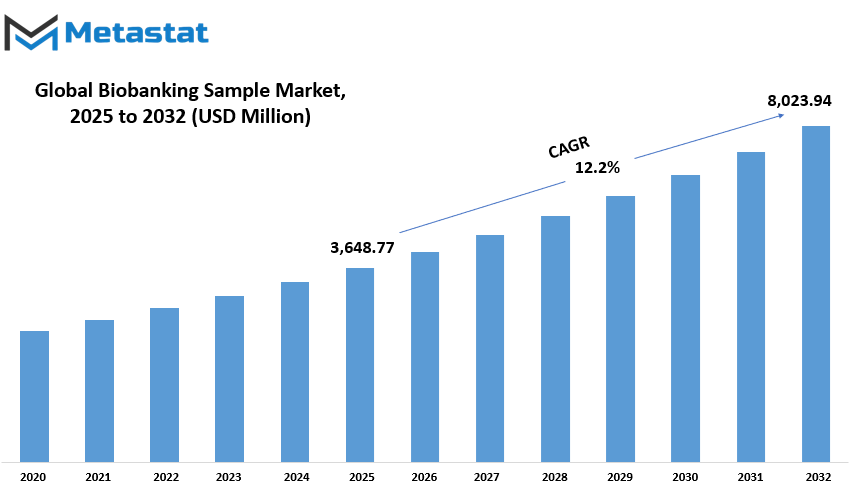
GROWTH FACTORS
The global biobanking sample market grows rapidly due to the increasing popularity of personalized medicine and advances made in genomic studies. These create a demand for well-managed efficient sample storage products that can support innovative breakthroughs for healthcare. Personalized medicine relies more on accurate samples and well-kept biological data to tailor remedies to individual specifications, making modern medical research biobanking much more important. Genomic research, too, benefits from the availability of high-quality samples, enabling scientists to explore genetic variations and develop targeted therapies.
Increased investment in biobanking infrastructure and initiatives related to precision healthcare is bolstering the market further. State-of-the-art facilities and sophisticated technologies are being funded by the government and private entities for constructing them so that the rising demand for biobanks is catered to effectively. This also focuses on the aspect of precision healthcare, shifting more towards a patient-centric approach with treatments based on an elaborate knowledge of genetic and environmental factors.
However, these positive trends could be thwarted by a number of challenges in the market. High establishment and maintenance costs of sample collection, storage, and management infrastructure represent a major hurdle for most organizations. Sophisticated equipment and technologies used in biobanking require huge investment in money that might be beyond the reach of small institutions. There are also issues with the ethics and regulation surrounding sample handling and the protection of patient data. Ensuring that samples are collected and used under strict guidelines is essential but can slow down operations and increase costs.
However, advances in cryopreservation and automated storage technologies are likely to create new opportunities for the market. These improve the longevity and accessibility of stored samples, enabling researchers to work with higher-quality materials over longer periods. Automated systems also improve efficiency by reducing the likelihood of human error and making retrieval faster and more reliable. These improvements not only address some of the existing challenges but also pave the way for further innovation in biobanking.
The biobanking sample market is expected to grow in the coming years as the focus on precision medicine and advanced healthcare solutions continues to rise. Overcoming the present obstacles with technologic advancements and strategic investments will be crucial in ensuring that biobanking fulfills its potential to support transformative developments in medical science.
MARKET SEGMENTATION
By Product and Services
The global biobanking sample market is a growing sector that is spurred by advancements in the fields of healthcare, research, and biotechnology. It plays an important role in preserving biological samples for future use in medical studies, diagnostics, and therapeutic developments. This market can be broadly categorized into product and service, which are essentially interdependent elements that go toward the general functioning and efficiency of biobanking operations.
In the product segment, equipment is significant, amounting to $1,687.64 million. The devices are basic to the storage and preservation of samples, thus maintaining their quality and usability for long periods. From ultra-low-temperature freezers to automated storage systems, the demand for reliable and advanced equipment is growing. As technology innovations enhance the precision and capability of these tools, they significantly contribute to the growth of the biobanking industry.
Consumables also play a very significant role in the market. The range of consumables available is extensive, from tubes and vials to reagents. All these are vital materials used for collecting, processing, and preserving biological specimens. The widespread use of consumables in applications indicates the need for them in ensuring sample integrity and successful high-quality research outcomes.
Services in this market are equally important, offering expertise in sample collection, transportation, and storage management. These services help institutions and organizations in need of assistance with biobanking procedures to be in compliance with industry standards and protocols. Software solutions also have a role in the management of biobanking operations, with the help of data management, tracking samples, and increasing overall efficiency. With increased reliance on digital systems, the use of specialized software has become an integral component of modern biobanking practices.
The integration of these factors reflects the holistic nature of the global biobanking sample market. Each segment, whether equipment, consumables, services, or software, uniquely contributes to addressing the diverse needs of researchers and healthcare professionals. As the need for innovative solutions remains high, it is anticipated that the market will continue to increase with ongoing requirements for efficient sample preservation and management. This progress reflects the growing role of biobanking in advancing scientific capabilities and enhancing global health results.
By Sample Type
The global biobanking sample market is segmented based on the types of samples stored and used for research and medical purposes. These categories include blood products, human tissues, cell lines, nucleic acids, biological fluids, and human waste products. Each sample type plays a specific role in advancing medical research, diagnostics, and therapeutic developments, which contributes to the overall growth of the biobanking industry.
Among those stored samples in biobanks, blood products such as plasma and serum are used the most. They play a vital role in studying disease, testing medications, and discovering markers that could indicate disease states. They can be used in clinical trials and personalized medicine. Disease mechanisms often depend on them for research on diseases such as cancer, diabetes, and heart conditions, paving the way for targeted treatments.
Human tissues are significant in the structural and functional analysis of various organs. These tissue samples allow the researcher to examine the progression of diseases and to assess the new therapies. Tissue samples are important in cancer studies, where tumors are analyzed for their behavior and resistance to the treatments. Through the preservation of such samples, biobanks guarantee that valuable biological material is available for long-term studies.
Cell lines are another important part of the biobanking sample market. They are used extensively in genetic research, drug development, and vaccine testing. These samples allow scientists to conduct experiments under controlled conditions, providing insights into cellular responses and interactions. Their role in advancing biotechnology and regenerative medicine cannot be overstated.
Nucleic acids, including DNA and RNA, are crucial for genetic studies and the development of diagnostic tools. The preservation of these molecules has led to advancements in understanding genetic disorders and hereditary diseases. Analysis of these helps researchers discover genetic markers associated with certain health conditions, opening avenues for new treatments and prevention.
Biological fluids, such as urine and saliva, are the best for non-invasive research into various health conditions. Such samples are invaluable in detecting diseases at an early stage and in monitoring treatment progress. Similarly, human waste products, though less conventional, are gaining attention for their potential in microbiome research and studying gut health.
This divergence in sample types in a biobank definitely showcases the relevance of these repositories in furthering science and medicine. Since samples are stored systematically, they allow better provisions for researchers to access quality materials leading to discoveries that will shape the future of medicine.
By Type of Biobank
The global biobanking sample market is an important part of contemporary scientific research, where precious samples for all kinds of studies are presented. The overall market can broadly be categorized as population-based biobanks and disease-oriented biobanks catering to the demands and requirements of different types of research.
Population-based biobanks mostly focus on gathering and storing biological samples from a very wide and varied group of individuals. Such biobanks are fundamental to studies focused on understanding health and disease determinants across populations. Genetic, environmental, and lifestyle data may then be analyzed in order to understand patterns and trends that could possibly lead to a breakthrough in preventive medicine, public health strategies, and personalized treatments. These biobanks also have long-term studies tracking the changes over time, helping scientists identify emerging health challenges and appropriate solutions.
Biobanks that are disease-oriented are especially designed to answer the needs of research that is aimed at particular illnesses or medical conditions. These biobanks collect samples from people afflicted with specific diseases, which would enable researchers to investigate causes, development, and possible treatments for those specific illnesses. An example would be in situations involving samples resected from disease-oriented biobanks for studies in cancer, cardiovascular diseases, neurological conditions among others. The data obtained in these studies form the backbone of advancements in diagnostic tools better therapeutic interventions, and quick development of new drugs.
Both types of biobanks are significant innovation and progress drivers in medical and scientific fields. They offer an opportunity for researchers, healthcare providers, and pharmaceutical companies to collaborate through access to high-quality, well-documented samples. This kind of collaborative environment makes studies more efficient and accurate, allowing researchers to draw meaningful conclusions and make informed decisions that can help improve global health.
As technology develops, the industry of biobanking will increase and grow further to accommodate demands in new areas of research and methodologies. Better techniques for storage, data management, and ethical frameworks will ensure these biobanks remain a valuable resource for the future. The global biobanking sample market, focusing on population-based and disease-oriented biobanks, is going to be of prime importance in meeting the challenges of modern medicine and developing a deeper understanding of human health. In fact, such biobanks help in developing cutting-edge research and innovative solutions that will enhance the quality of life for individuals across the globe.
By Application
The global biobanking sample market is a very important aspect of modern science and healthcare. Applications range from the most advanced in regenerative medicine, life science research, clinical research, drug discovery and development, personalized medicine, to forensic applications. All these are individual uses of biobanking and show how significant it is to the development of medical and scientific progress.
In the field of regenerative medicine, biobanking is essential in storing samples of stem cells, tissues, and other biological materials. These samples are important in developing therapies meant to repair or replace damaged tissues and organs. The availability of good-quality samples therefore supports advancements offering hope to patients with chronic conditions or injuries for which traditional treatments are not satisfactory.
Life science research depends on biobanking as a basis for the study of biological processes, diseases, and potential interventions. Stored samples are used by researchers to gain insights into how organisms function, which helps them identify potential therapeutic targets. Biobanking contributes to accelerating discoveries that will deepen understanding about health and disease.
Supporting clinical trials, biobanking provides relevant biological samples for assessing the safety and effectiveness of new treatments in clinical trials. When diverse samples are well-preserved, studies are conducted more efficiently and produce accurate results, which is critical when developing treatments for rare diseases and specific patient populations where sample collection can be difficult.
Biobanking also benefits drug discovery and development activities. Pharmaceutical companies need access to the biological samples for testing their new compounds, studying mechanisms of disease, and developing targeted therapies to cure the illnesses. With this application, the entire process of drug development is streamlined, and thus less time is taken to bring the treatments to market.
Personalized medicine is another area where biobanking has a transformative impact. By storing samples that reflect individual genetic and biological variations, biobanking enables tailored treatments that address the unique needs of each patient. This approach not only improves treatment outcomes but also minimizes the risk of adverse effects.
Finally, in forensic science, biobanking is essential in the preservation of biological evidence that is used in criminal investigations. Accurate identification and analysis can be made with well-stored samples, which would ensure that justice is served appropriately.
The global biobanking sample market supports these diverse applications and continues to drive progress in healthcare, science, and justice, making it a cornerstone of innovation and societal advancement.
|
Forecast Period |
2025-2032 |
|
Market Size in 2025 |
$3,648.77 million |
|
Market Size by 2032 |
$8,023.94 Million |
|
Growth Rate from 2024 to 2031 |
12.2% |
|
Base Year |
2024 |
|
Regions Covered |
North America, Europe, Asia-Pacific, South America, Middle East & Africa |
REGIONAL ANALYSIS
The global biobanking sample market is segmented geographically, showing its widespread existence in various regions. These include North America, Europe, Asia-Pacific, South America, and the Middle East & Africa, all of which add to the market dynamics differently. This kind of segmentation would give insight into growth patterns, opportunities, and challenges within various parts of the world.
North America is a significant player in the biobanking sample market, further divided into the United States, Canada, and Mexico. Among these, the U.S. is a major contributor, driven by advanced healthcare systems, research infrastructure, and the increasing demand for biobanking in clinical and research applications. Canada and Mexico also support the market with growing initiatives in biotechnology and healthcare advancements.
Market segmentation for Europe The market covers United Kingdom, Germany, France, Italy, and the Rest of Europe. There is strong funding from the government for biomedical research and a comprehensive network of facilities for biobanking in this region. Germany and the UK have been leading in innovation and hence are significantly advancing the research area of personalized medicine and disease prevention.
Asia-Pacific is considered a gateway of tremendous potential because its healthcare sector is rising at a high pace and large amounts of investments go into biotechnological research. It further includes countries like India, China, Japan, South Korea, and the Rest of Asia-Pacific. China and India are emerging as the most dominant ones due to increased infrastructure and efforts in genetic and clinical research. Japan and South Korea, through technological advancements and government programs, also add to this market.
The South American region, of which Brazil, Argentina, and the Rest of South America comprise, presents constant growth in this biobanking sector. Increased research activity continues to gain popularity in Brazil along with the rise in interest from region-specific diseases and health issues in the country.
The Middle East & Africa region, comprising GCC Countries, Egypt, South Africa, and the Rest of the Middle East & Africa, is gradually developing its biobanking capabilities. Improvements in healthcare systems and efforts toward tackling pressing health issues in the regions are thus creating opportunities for growth.
It identifies the various geographical segments that can influence the demand of the biobanking sample. Every region gives its own specific growth contribution depending on its specialty in terms of technology, research concentration, and priority of healthcare.
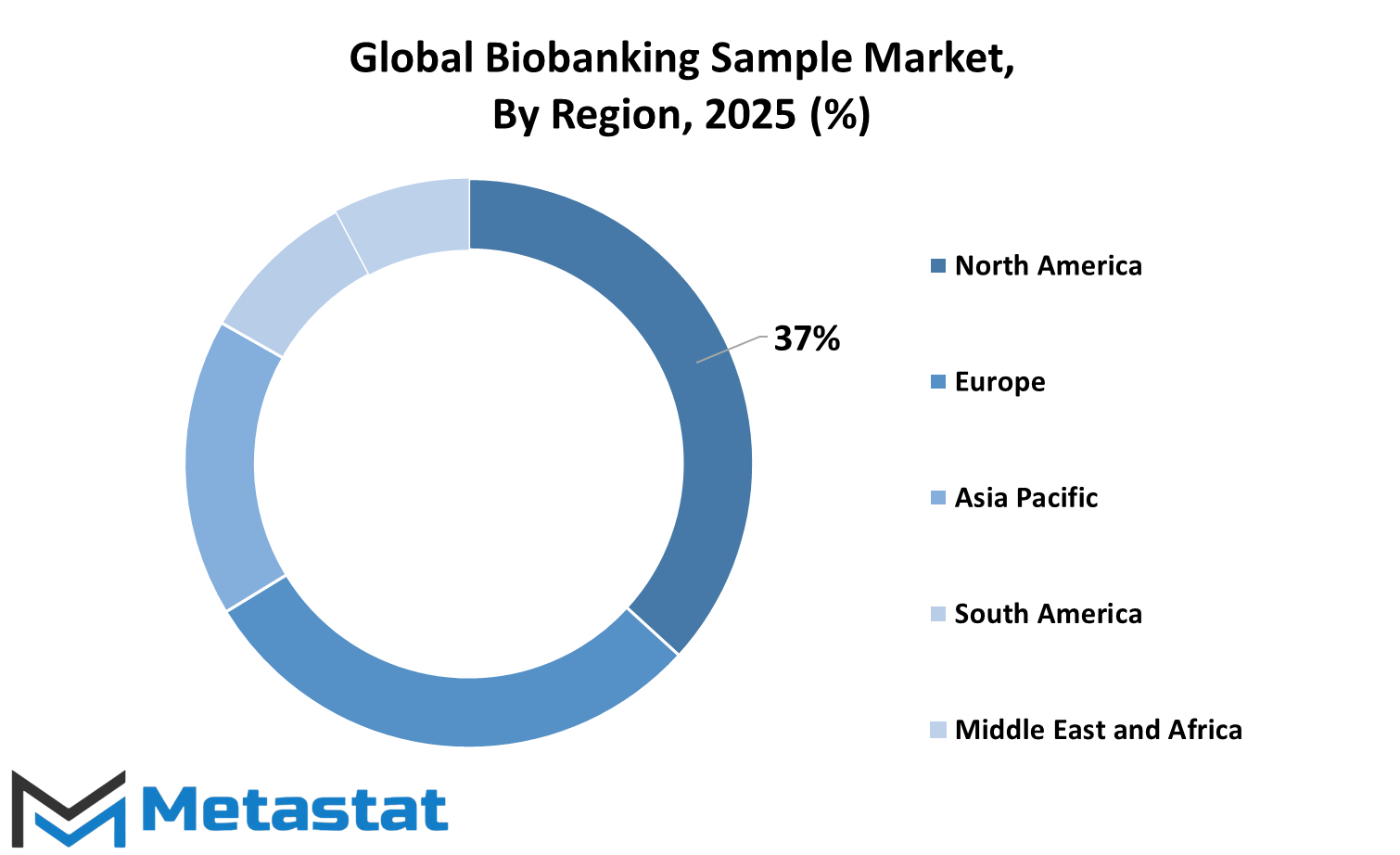
COMPETITIVE PLAYERS
Global Biobanking Sample Market The demand for biobanks in different fields, including research, healthcare, and pharmaceuticals, has caused the global biobanking sample market to gain significant growth over the past few years. Contributions from key players are significant in this market since their innovative products and services serve as the primary tools for the collection, storage, and management of biological samples.
Such companies as Thermo Fisher Scientific Inc. and Qiagen N.V. are a basis for developing sophisticated technologies, which help preserve and analyze biological materials. Such contributions allow biobanks to offer high-quality samples for the purpose of conducting medical research, diagnostics, and drug development. For instance, Thermo Fisher Scientific provides a number of equipment and technologies designed specifically for biobanks, allowing the samples to be stored in optimal conditions so that they maintain their integrity over time.
Another major player in the market is PHC Holdings Corporation. The company specializes in laboratory and storage solutions that support the work of biobanks around the world. By offering reliable systems, PHC Holdings helps maintain the quality and viability of biological samples, which is important for the accuracy of the research outcome. In addition, Hamilton Company offers cutting-edge liquid handling equipment, which aids in the precise collection and management of biological samples, streamlining biobanking processes and improving overall efficiency.
VWR International, LLC, Cryoport, Inc., and Biokryo GmbH also contribute to the biobanking sample market by offering advanced storage solutions, transportation services, and temperature-controlled systems. These services are critical for maintaining the cold chain required for preserving samples at extremely low temperatures, especially when transporting them over long distances.
Tecan Trading AG, SPT Labtech, Cell and Co Biobank, and CTIBiotech, among others, also concentrate on specialized laboratory equipment and automation systems for sample handling and storage. Automation makes biobanks more efficient because it minimizes human error and increases the uniformity of sample management.
More additional services are added to the biobanking sector through companies such as Cureline, Firalis Group, Sopachem, and US Biolab Corporation, Inc. Their additional services will add up in enhancing the sectors that provide sample analysis and research capabilities to enhance medical research for the development of new treatments.
Overall, the driving forces behind key players in biobanking sample industries are forcing innovation, and improving efficiency together with safe reliable management of their biological samples is helping to perpetuate the constant progress in fields of medical research, personalized medicines, and pharmaceutical drug development.
Biobanking Sample Market Key Segments:
By Product and Services
- Equipment
- Consumables
- Service
- Software
By Sample Type
- Blood Products
- Human Tissues
- Cell Lines
- Nucleic Acids
- Biological Fluids
- Human Waste Products
By Type of Biobank
- Population-based Biobanks
- Disease-oriented Biobanks
By Application
- Regenerative Medicine
- Life Science Research
- Clinical Research
- Drug Discovery and Development
- Personalized Medicine
- Forensics
Key Global Biobanking Sample Industry Players
- Thermo Fisher Scientific Inc.
- Qiagen N.V.
- PHC Holdings Corporation
- Hamilton Company
- VWR International, LLC
- Cryoport, Inc.
- Biokryo GmbH
- Tecan Trading AG
- SPT Labtech
- Cell and Co Biobank
- CTIBiotech
- Cureline
- Firalis Group
- Sopachem
- US Biolab Corporation, Inc
WHAT REPORT PROVIDES
- Full in-depth analysis of the parent Industry
- Important changes in market and its dynamics
- Segmentation details of the market
- Former, on-going, and projected market analysis in terms of volume and value
- Assessment of niche industry developments
- Market share analysis
- Key strategies of major players
- Emerging segments and regional growth potential




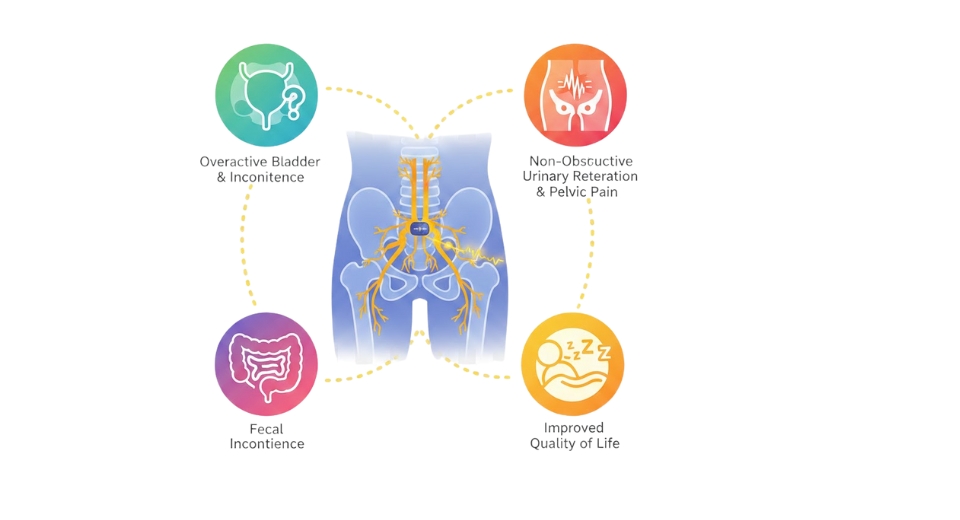
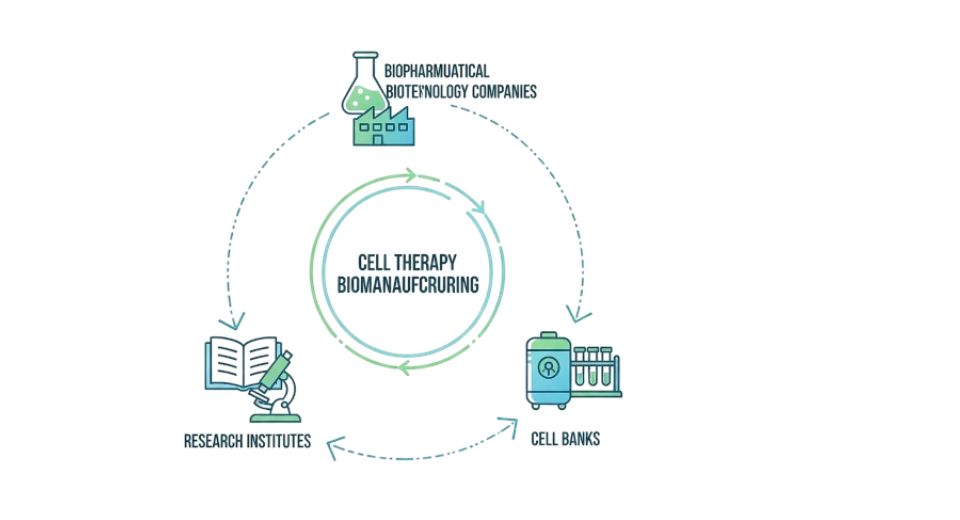
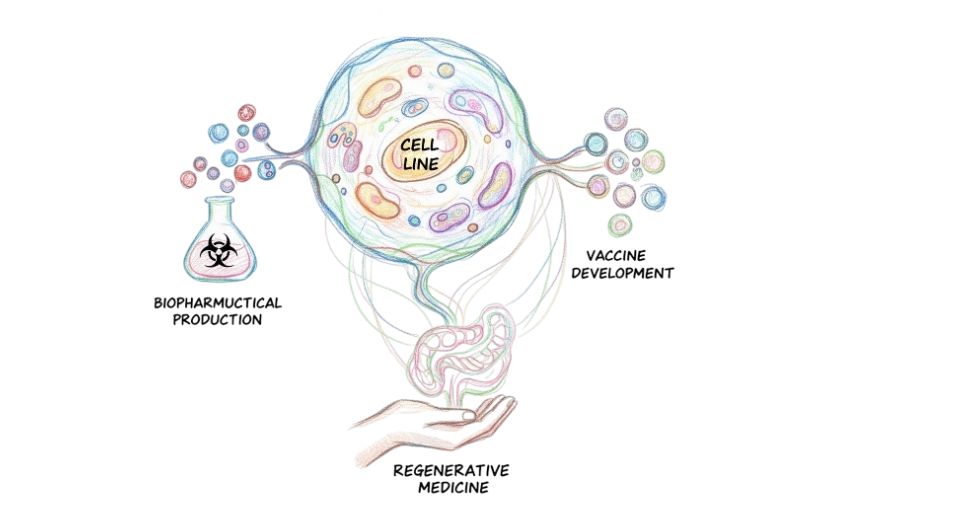

 US: +1 3023308252
US: +1 3023308252






